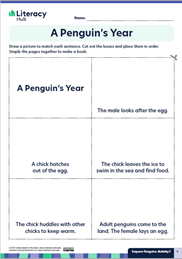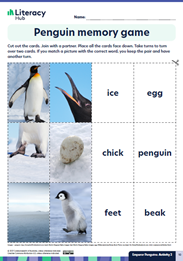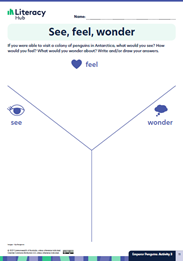Emperor Penguins
This non-fiction report focuses on the emperor penguin, how it survives in a cold climate, how it finds its food, and how it looks after its young.
Back to the shared reading overview page
Text download
Emperor Penguins as PDF (798KB) (opens in new window)
Emperor Penguins as PowerPoint slideshow (8.2MB) (download)
Printable worksheets
|
|
|
|

Teaching & learning sequence
This teaching and learning sequence outlines classroom strategies for Emperor Penguins, including:
- ways to incorporate the ‘Big Six’ core elements of reading development
- fun, engaging and adaptable student activities for a diverse range of abilities
- links to the Australian Curriculum.
| Text features | Cross-curriculum links to the Australian Curriculum |
|

First read
As a whole group, enjoy sharing the text and learning together.
Engage
Discuss students’ prior knowledge: What do you know about Antarctica? What animals might live there? Would it be difficult to survive in Antarctica? Why do you think this?
Draw up a T-chart with the headings Know/Learnt. Explain that you are going to read a book about penguins. What do you already know about penguins? List students’ responses in the first column of the T-chart (keep to revisit later).
Have students talk to a partner about what they would like to learn about penguins.
Read aloud
Show the front cover: What does the front cover tell us about the book? Discuss.
Discuss the table of contents: What do you think you will learn about by reading this book? Have students talk with a partner about their predictions.
Talk through the book as you read aloud. For example, point out and discuss the various features and graphics on each page. What does the heading tell you? What extra information do the photos give you? What does the diagram tell us?
Make meaning
Discuss initial understandings. What did you learn about emperor penguins? What surprised you?
Have students share their ideas and use these to add comments in the second column of the Know/Learnt T-chart.
Revisit the text
Return to the text several times to look more closely at different aspects of its content, structure and language features. This is a great vehicle for exploring the ‘Big Six’ of literacy in an integrated way, with all components linking to the same text.
Comprehension
Reading is about making meaning. Choose from these comprehension activities to help your students explore the text deeply, make personal connections, develop new understandings, and draw conclusions. The activities will also help students analyse the text, think critically about it and form their own opinions.
Talking text types (whole-group activity)
Discuss the text type and its purpose. What sort of book is this? What is its purpose? How do you know this? Have students turn and talk to their partner. Pairs share their ideas. Draw out that the book is a non-fiction report – it gives us information and facts.
Revisit the book and invite students to point out various features of a non-fiction report, for example, table of contents, headings, labelled diagrams, photographs, maps and topic sentences. Make a list of these features on a chart.
Students could browse through non-fiction books in the classroom to identify these and other features of non-fiction texts. Add any further features to the class chart.
Australian Curriculum links
Organising information (whole-group activity)
Revisit the table of contents page, and discuss. How has the author organised the information? How do these headings help us to read the book?
What other information could the author have included about penguins? What headings would you have included?
Australian Curriculum links
Viewing visuals (whole-group activity)
Revisit the text. As you view each page, ask students to identify visual devices (labelled globe, labelled diagram of a penguin, time line). What extra information does this visual give you? Why do you think the author chose to represent the information in this way?
Explain that the images in a factual text can give the reader extra information that is not included in the text. Choose an image to share and ask students to think about the information that is contained in the image. Discuss.
Australian Curriculum links
New learning (small-group activity)
Have students work in a small group to write and/or draw three things they have learnt about emperor penguins. Have small groups take turns to share their new learnings with the whole group.
Australian Curriculum links
Make a mini-book (individual activity)
Revisit the time line on pages 14 and 15. Discuss the events that happen throughout the year.
Have students make a book that outlines a year in a penguin’s life using the printable worksheet. Have them draw a picture in each box to match the sentence, cut out the boxes, and staple the pages together in order. Encourage students to refer to the time line in Emperor Penguins to ensure they have ordered the pages correctly in their book.
Students can read their book to another child or class in the school.
Print A Penguin’s Year worksheet.
Australian Curriculum links
Phonological awareness (including phonemic awareness)
These activities will help students to hear the sounds and rhythms of language. Guide them as they explore syllables, onset and rime and listen for phonemes - the smallest units of sound within a word. Use the activities to help your students identify the phonemes in words and practise blending, segmenting and manipulating these sounds.
Odd one out (whole-group activity)
Choose topic words from the text to play a game of ‘odd one out’. Say three or four words slowly and clearly. Explain to students that there will be one word that doesn’t begin with the same sound as the other words. Ask them to identify which word is the odd one out, and why they think this. For example:
- penguin, seal, prey, predator
- swimming speeds, strong, shellfish
- flipper, swim, fly
- chick, cold, climate, colony
Differentiate this activity by choosing word groups that focus on the sounds your learners already know and are able to identify.
Australian Curriculum links
Listening for long vowel sounds (whole-group activity)
If your students have a good understanding of the long e sound you could reinforce this by drawing their attention to words from the text that have this sound such as ‘feet’, ‘deep’ and ‘beak’. Say one of these words aloud, segmenting the individual phonemes, and ask students to listen for the sounds they hear: ‘feet’ – f, long e, t. Discuss as a group. Highlight the medial long e sound.
Repeat with the other words with the long e sound (deep, beak). Have students talk with a partner about further words they know that have this long e sound. Have pairs share their ideas.
Repeat with other long vowels as appropriate, for example, long a as in ‘prey’ and ‘lay’, long i as in ‘dive’, long o as in ‘ocean’.
Australian Curriculum links
Phonics
Evidence shows that children learn best about the relationship between phonemes and graphemes through a daily structured synthetic phonics program (also known as systematic synthetic phonics). Knowing about these relationships will help students to decode, and this is crucial for their continued reading development.
In addition to your phonics program it is helpful to expose students to letter sound relationships they come across in other contexts, such as during shared reading experiences. Choose activities that are relevant to your students so they can practise and reinforce already learnt concepts, so as to build automaticity in recognising letter sound relationships.
Matching letters to sounds (whole-group activity)
Help students to reinforce their knowledge of the long e sound and how it is represented. You can do this by writing the words ‘feet’, ‘deep’ and ‘beak’ on a chart. Underline the letters in each word that make the long e sound. Ask students to say the word to their partner and to listen to the sound that the underlined letters make. Highlight that these words have the long e sound, but it is represented in different ways - ‘ee’ and ‘ea’.
Have students think of other words with the long e sound. Add these to the chart and discuss the letters that make the sound in each of the words.
Australian Curriculum links
Identifying words with adjacent consonants (whole-group activity)
Revisit page 10 of the text. Have pairs of students work together to identify all the words that begin with the f sound (finding, food, fly, flippers, finds, fish). Use students’ feedback to create a list on a chart. Invite a student to underline the letter that makes the f sound in each word.
Highlight the words ‘fly’ and ‘flipper’. Ask students to say the first two sounds in the word – f and l. What are the first two sounds in these words? Explain that when two consonants sit one after the other, the sounds need to be blended together. Have students think of other words that begin with the adjacent consonant sounds f and l (e.g. flea, flash, flight, flick, flip).
If appropriate for your students use the text to focus on other words beginning with adjacent consonants (e.g. prey, predator, climate, swimming, speed, strong, squid).
Australian Curriculum links
Oral language
Oral language development begins at birth, and having a rich oral language is beneficial as a foundational and ongoing resource for literacy development. Oral language is embedded throughout the shared reading experience as students listen and respond to quality texts.
It is also valuable to involve students in specific activities that will continue to improve their oral language skills. Choose from these activities to help students develop and practise important communication skills.
Retelling (partner activity)
Revisit the time line on pages 14 and 15. Reread and discuss.
Have students sit with a partner and take turns retelling the main events that happen throughout a penguin’s year. Encourage students to think carefully about their role as a speaker and a listener. How will you show that you are listening to your partner? How will your voice sound when you are speaking?
Australian Curriculum links
Penguin speak (partner activity)
Present the scenario: If you were a penguin what would you tell our class about your life? Be creative! Using the think-pair-share strategy have students think about this, talk with a partner, and then invite pairs to share their ideas with the group.
Australian Curriculum links
Fluency
Activities aimed at teaching and practising fluency are important for students in their journey to become independent readers. Explicitly modelling fluency, and providing opportunities for students to practise reading aloud, will facilitate their development in this area.
Modelled reading (whole-group activity)
Revisit the text. Have students listen carefully as you read a page or section. Model reading the text smoothly, with expression. Ask students to take notice of how your voice sounds. Discuss and draw out that fluent reading sounds smooth and is easy to understand.
Australian Curriculum links
Vocabulary
Having a rich, broad vocabulary assists students when they are tackling new texts. These vocabulary activities will help them to build their growing bank of words.
The activities introduce students to new Tier 2 and Tier 3 words, as well as exploring word families and a range of different word types.
What’s in a name? (whole-group activity)
Draw the students’ attention to the name ‘emperor penguin’. Do you know what an emperor is? Discuss and draw out that an emperor is a person who is a ruler, like a queen or a king. Ask: Why do you think this type of penguin is called an emperor penguin? Does the penguin remind you of a ruler? Listen and discuss the students’ ideas. Draw the students’ attention to the fact box on page 9, and read aloud. Does this add to your ideas? Discuss.
Australian Curriculum links
Exploring word families (whole-group activity)
Highlight the word ‘swimming’ on page 8 and write it on a chart. Ask students if they see a smaller word within this word, and invite a student to underline ‘swim’.
Have students talk with a partner about other words with the base word ‘swim’. Add their suggestions to the chart and extend their thinking by adding any further words that were not suggested (swimmer, swimmers, swimsuit, swimwear, swimming, non-swimmer, outswim).
Australian Curriculum links
Penguin body parts (whole-group activity)
Refer back to the book to locate the names of the penguin’s body parts, and the words used to describe them (e.g. flipper-like wings, webbed feet, waterproof feathers, white underbelly). Create a list on a chart.
Discuss the difference between the body parts (nouns) and the words used to describe them (adjectives). Have students think of other words that are used to describe the body parts of animals, such as an elephant’s long, grey trunk or a tiger’s sharp, pointy teeth.
Australian Curriculum links
Draw and label (independent activity)
Have students draw a picture of a penguin and label it. Encourage them to refer to the book to locate the names of the body parts.
Australian Curriculum links
Penguin memory game (partner activity)
Write the following content vocabulary from the text onto a chart (ice, egg, chick, penguin, beak, feet). Talk about each word, and what it means. Students can then join with a partner to play a game of memory by matching the words with the correct image. Print a copy for each student to play a game of memory with a partner.
Print the Penguin memory game worksheet.
Australian Curriculum links
Reflecting on learning
Help students ‘bring it all together’ and reflect on their understandings by completing the graphic organiser either independently or with a partner.
See, feel, wonder Y-chart
Discuss what the students know about penguins, and how they feel about them. Talk about the things they still wonder about. Have them fill in the See, feel, wonder graphic organiser.
For families - new for 2024!Reinforce your classroom learning by telling families in your class about Emperor Penguins. Families can share the text at home and use the information provided to build knowledge and instill a love of reading. |


